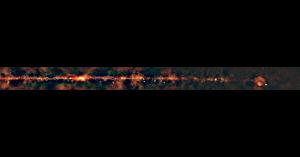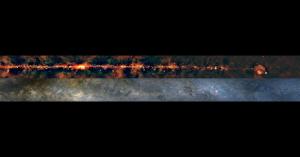A new, expansive view of the Milky Way reveals our Galaxy in unprecedented radio colour

Caption: The GLEAM-X view of the Milky Way, as seen from the southern hemisphere, in radio colour. Credit: Silvia Mantovanini & the GLEAM-X Team
ICRAR astronomers produced the most detailed low-frequency radio image of the Milky Way, revealing new insights into stars and galactic structure.
PERTH, AUSTRALIA, October 29, 2025 /EINPresswire.com/ -- Astronomers from the International Centre of Radio Astronomy Research (ICRAR) have created the largest low-frequency radio colour image of the Milky Way ever assembled.
This spectacular new image captures the Southern Hemisphere view of our Milky Way galaxy, revealing it across a wide range of radio wavelengths, or ‘colours’ of radio light.
It provides astronomers with new ways to explore the birth, evolution, and death of stars in our Galaxy.
Silvia Mantovanini, a PhD student at the Curtin University node of ICRAR, dedicated 18 months and over 40,000 hours to construct the image by using the supercomputers at the Pawsey Supercomputing Research Centre to process and compile the data from two extensive surveys.
The surveys were conducted using the Murchison Widefield Array (MWA) telescope located at Inyarrimanha Ilgari Bundara, the CSIRO Murchison Radio-Astronomy Observatory on Wajarri Yamaji Country in Western Australia.
These were the GaLactic and Extragalactic All-sky MWA (GLEAM) and GLEAM-X (GLEAM eXtended) surveys, respectively conducted over 28 nights in 2013 and 2014, and 113 nights from 2018 to 2020.
The new image, which focuses on our own Galaxy, offers twice the resolution, ten times the sensitivity, and covers twice the area compared to the previous GLEAM image released in 2019. This significant improvement in resolution, sensitivity and sky coverage allows for a more detailed and comprehensive study of the Milky Way, providing astronomers with a wealth of new data and insights.
“This vibrant image delivers an unparalleled perspective of our Galaxy at low radio frequencies,” Ms Mantovanini said.
“It provides valuable insights into the evolution of stars, including their formation in various regions of the Galaxy, how they interact with other celestial objects, and ultimately their demise.”
Ms Mantovanini’s research focuses on supernova remnants, the expanding clouds of gas and energy left behind when a star explodes at the end of its life. Although hundreds of these remnants have been discovered so far, astronomers suspect that thousands more are waiting to be found.
The image allows them to distinguish between the gas surrounding new stars and that left behind by dead ones, revealing clearer patterns in the cosmic landscape.
“You can clearly identify remnants of exploded stars, represented by large red circles. The smaller blue regions indicate stellar nurseries where new stars are actively forming,” Ms Mantovanini said.
The image may also help unravel the mysteries surrounding pulsars in our Galaxy. By measuring the brightness of pulsars at different GLEAM-X frequencies, astronomers hope to gain a deeper understanding of how these enigmatic objects emit radio waves and where they exist within our Galaxy.
Associate Professor Natasha Hurley-Walker from the same ICRAR team, who is the principal investigator of the GLEAM-X survey, emphasised how this is a big step forward in studying the Milky Way’s structure.
“This low-frequency image allows us to unveil large astrophysical structures in our Galaxy that are difficult to image at higher frequencies,”
“No low-frequency radio image of the entire Southern Galactic Plane has been published before, making this an exciting milestone in astronomy.”
“Only the world’s largest radio telescope, the SKA Observatory’s SKA-Low telescope, set to be completed in the next decade on Wajarri Yamaji Country in Western Australia, will have the capacity to surpass this image in terms of sensitivity and resolution,” concluded Associate Professor Hurley-Walker.
The surveys involved hundreds of hours of data collection using the MWA radio telescope located at Inyarrimanha Ilgari Bundara, the CSIRO Murchison Radio-astronomy Observatory. The ICRAR researchers catalogued an impressive 98,000 radio sources across the Galactic Plane visible from the southern hemisphere, showcasing a diverse mix of pulsars, planetary nebulae, compact HII regions - which are dense, ionised gas clouds in space - and distant galaxies unrelated to the Milky Way.
The paper “GaLactic and Extragalactic All-sky Murchison Widefield Array survey
eXtended (GLEAM-X) III: Galactic Plane” was published overnight in Publications of the Astronomical Society of Australia (PASA).
Charlene D'Monte
International Centre for Radio Astronomy Research
+61 468 579 311
email us here
Caption: Astronomers reveal an incredible new radio view of our Galaxy Credit: ICRAR
Legal Disclaimer:
EIN Presswire provides this news content "as is" without warranty of any kind. We do not accept any responsibility or liability for the accuracy, content, images, videos, licenses, completeness, legality, or reliability of the information contained in this article. If you have any complaints or copyright issues related to this article, kindly contact the author above.


